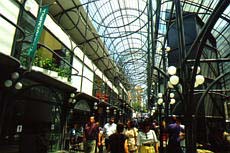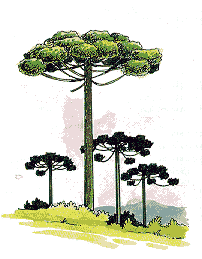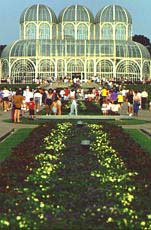Advertising by Google
Curitiba, Paraná
Area: 431 km2
Population: 1.587.315 inhab. (est. 2000).
With a population of more than one million and a half inhabitants, Curitiba, Paraná state's capital is considered a standard city. The innovating solutions to the urban planning, the concern about environment revealed on the parks and cycle lanes and the cultural equipments that humanize life on the city has turned Curitiba into one of best living quality places on the country and has attracted attention of specialists in Urbanism around the world.

24 Hour Street
Education and health have been treated as priority services. The city's Bus Rapid Transportation system is a model for major cities in Brazil and the World. The green area - 52 m2 per inhabitant - is far in excess of the 16 m2 per inhabitant minimum recommended by the UN. Wide pavements, Rua 24 Horas (24 Hours Street), conservation of the architectural heritage and selective refuse collection have been conceived with the well-being of the population of Curitiba as the starting point.
 Curitiba was born in the shade of Paraná pines a little over three hundred years ago. Its name bears its native heritage: kur ity ba, as the Indians used to call the pine-kernels, the fruits of the Paraná pines and the symbolic tree of Paraná. The city came into being when the gold prospectors from the coast travelled up-river to the Serra do Mar arriving at the plains. The first nucleus settled on the banks of the River Atuba in a place called Vilinha. Soon afterwards, the urban centre was transferred to the site of the present Tiradentes Square. It was in this area that the town of Nossa Senhora da Luz do Pinhais had its beginnings, being officially founded on March 29th, 1693. In 1842, the town acquired city status with the name Curitiba, before being elevated to state capital in 1853.
Curitiba was born in the shade of Paraná pines a little over three hundred years ago. Its name bears its native heritage: kur ity ba, as the Indians used to call the pine-kernels, the fruits of the Paraná pines and the symbolic tree of Paraná. The city came into being when the gold prospectors from the coast travelled up-river to the Serra do Mar arriving at the plains. The first nucleus settled on the banks of the River Atuba in a place called Vilinha. Soon afterwards, the urban centre was transferred to the site of the present Tiradentes Square. It was in this area that the town of Nossa Senhora da Luz do Pinhais had its beginnings, being officially founded on March 29th, 1693. In 1842, the town acquired city status with the name Curitiba, before being elevated to state capital in 1853.
Curitiba was one of the preferred places of European immigrants that arrived on Brazil since the XIX century - mainly Germans, Italians, Poles and Ukrainians. The presence of these people had a great influence on the way of city. Besides the typical accents, the cookery of the restaurants reveals the origins of its population.

Bothanic Gardens
Holder of the title of Brazilian city offering the best quality of life, Curitiba is the forerunner in terms of concern for ecology, setting up Brazil's first environmental university, the Open University of the Environment, which carries out projects relating to a sustainable economy, conservation of the ecosystem and environmental education. Deep in a native forest covering 37,000 m2, its researchers are highly aware and are influencing the growth of the city, which bases its economy on trade, the provision of services and processing industries, scattered across Curitiba's Industrial City.
In addition, the city has one of Brazil's best public transport systems, having exported several of its schemes, such as the Integrated System, which was sold to New York. Curitiba was the first Brazilian city to implement the selective collection of refuse and publicize information on recycling processes.
The well-being of the citizen is the main preoccupation of the city, whose urban expansion is planned so as to avoid stress for its inhabitants. In order for both residents and visitors to enjoy the numerous parks and the city's pure air, the local corporation has organized a special bus service. But the city's trademark is the pine-kernel footprint walk. This is a three kilometre route that can be walked,cycled or travelled along by a special bus running between the city's tourist spots. By following the enormous pine-kernels painted on the ground, the visitor can follow a cultural and historical route that forms part of the Footprints in the Memory projects leading to churches, historic buildings and squares.
Read more:
Curitiba official site. Maintained by the Curitiba City Government.
Curitiba Guide. Compiled by Veja Magazine.
Universidade Federal do Paraná. The Federal University of Paraná, campus of Curitiba.
Back to Top